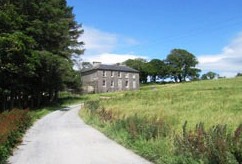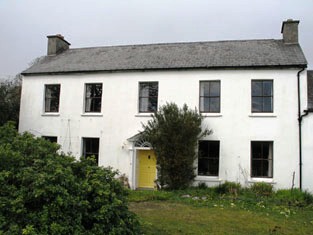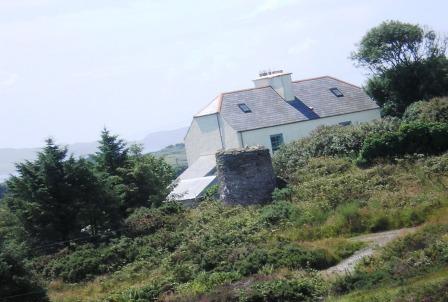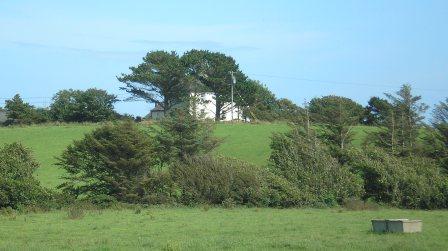Derreennatra Manor
Houses within 10km of this house
Displaying 23 houses.
Houses within 10km of Derreennatra Manor
Displaying 23 houses.
| House name | Description | |
|---|---|---|
| Glen | Rev. Edward Spring was leasing this property from Sir H. Beecher at the time of Griffith's Valuation, when it was valued at £6. Cape Clear Island Youth Hostel's website indicates that it was originally the coastguard station and later occupied by Rev. Edward Spring as he tried to establish a protestant congregation on the island. In 1906 Sir John Becher owned a property valued at £10 at Glen East. |

|
| Westfield | At the time of Griffith's Valuation, Margaret Long was leasing this property to Rev. John Coppinger when it was valued at £13 15s. The house is still extant and occupied. |

|
| Whitehall | Edward Townsend held this property in fee at the time of Griffith's Valuation, when it was valued at £22. Lewis noted it as the residence of S. Townsend in 1837. In 1906 it was owned by the representatives of Samuel R. Townsend and valued at £21. Bence-Jones indicates that it later became the property of the Alleyne family. The Irish Tourist Association reported in the early 1940s that it was still occupied at that time. |

|
| Marsh House | Robert Tighe was leasing this property to William Jago at the time of Griffith's Valuation, when it was valued at £14 5s. A house is still extant at the site. | |
| Springville | Thomas S. Fleming was leasing this property to Richard Long at the time of Griffith's Valuation, when it was valued at £7 15s. A house is still extant at the site. | |
| Inane | At the time of Griffith's Valuation, Rev. Richard Marmion was leasing this property to Thomas Long when it was valued at £16 5s. Noted by Lewis as the seat of H. Marmion in 1837, it is labelled Inane on both the 1st-edition and 25-inch Ordnance Survey maps. There is still an extant house at this site. A smaller property in the same townland, labelled Inane Cottage [W042286], was leased by Patience Marmion from Samuel Townsend in 1853, when it was valued at almost £4. A house still exists at this site also. | |
| Baltimore House | Jane Freke was leasing this property from Lady Carbery's estate at the time of Griffith's Valuation, when it was valued at £12 10s. Lewis notes Baltimore Castle as the residence of Mrs. Freke in 1837. The building labelled Baltimore House on the 1st and 25-inch edition Ordnance Survey maps is still extant. Baltimore Castle is an older, seventeenth century building which has recently been restored. |

|
| Castle House (Baltimore) | William Cuthbert was leasing this property from Lady Carbery's estate at the time of Griffith's Valuation, when it was valued at £12 5s. In 1837 Lewis noted Baltimore House as the seat of Jno. Collins. This house is no longer extant and modern buildings occupy the site. | |
| Aghadown House | At the time of Griffith's Valuation, Aghadown House, owned by William Jago, was unoccupied and valued at £8. Lewis had noted Aghadown as the seat of H. Becher in 1837. [The 25" Ordnance Map shows a second house, also called at Aghadown House, at W049334] The original Aghadown House is shown on Taylor and Skinner's 1783 map as a seat of the Banfield family and Wilson refers to it as the seat of "Benjamin Bonsfield" in 1786. In the early 1940s the Irish Tourist Association survey noted that "of this mansion, one ivy-covered gable and the gazebo remain". The National Inventory of Architectural Heritage notes that the extant building may previously have been the steward's house when the original house was still occupied. |

|
| Greenmount House | Daniel Connor was leasing this property to Thomas Atridge at the time of Griffith's Valuation, when it was valued at almost £9 and stood on a holding of 300 acres. In 1837 Lewis recorded Greenmount as the seat of Captain Long but in 1814 Leet refers to it as the seat of Thomas Atbridge [sic]. There is still a house at this site, undergoing renovation in 2009. |

|
| Roaring Water Cottage | At the time of Griffith's Valuation, John F. Townsend was leasing this property to Frances Long, when it was valued at £8. Lewis mentions Roaring Water House as the residence of J. O'Sullivan in 1837. The house is still extant and occupied. | |
| Ardmanagh House | John Limerick was leasing this property to Thomas Nicholls at the time of Griffith's Valuation when it was valued at £10. Substantial modern building has taken place in the area. | |
| Ballydehob Cottage | At the time of Griffith's Valuation, Patience Noble was leasing this property to William J. Swanton, when it was valued at £8 10s. In 1906 it was owned by Robert Swanton and valued at £10 10s. | |
| Rock Cottage (Skull) | James O'Callaghan was leasing Rock Cottage from the Earl of Bandon's estate at the time of Griffith's Valuation, when it was valued at £11. In 1837 Lewis had recorded it as the residence of J. O'Callaghan. James O'Callaghan owned over 450 acres in the area in the 1870s. Operated as a guesthouse in the later twentieth century and offered for sale in 2009. |

|
| Cappagh House (Skull) | Thomas S. Cave held this property in fee at the time of Griffith's Valuation, when it was valued at £20. Named as Cappagh House on the 1st edition Ordnance Map but not shown on the later 25-inch map. |

|
| Seafort | Mountifort Longfield was leasing this property to Stephen Browne at the time of Griffith's Valuation, when it was valued at £9 10s. May possibly have been owned by William Hull in 1814. In 1894, Slater refers to it as a residence of Mountifort Longfield. The house is still extant, together with extensive farm buildings. |

|
| Rickfield Cottage (Skull) | Hugh Swanton was leasing this property from the Connor estate at the time of Griffith's Valuation, when it was valued at £5. Buildings are still extant at the site. | |
| Rickfield (Skull) | At the time of Griffith's Valuation, Robert Swanton was leasing this property from the Connor estate when it was valued at £6 5s There are still buildings at the site. | |
| Leamcon House | At the time of Griffith's Valuation, William Hull held this property in fee when it was valued at £20. It had also been noted by Lewis as the seat of the Hull family in 1837. In 1814 it was the residence of R.E. Hull. The 1st-edition Ordnance Map also indicates the site of Old Leamcon House as well as a defensive battery. Leamcon House is still extant and occupied. |

|
| Lissacaha Cottage | Phillip Somerville held this property in fee at the time of Griffith's Valuation, when it was valued at £12 10s. It is labelled "Lissacaha Cottage" on the 1st edition Ordnance Map but has become "Prairie Cottage" on the later 25-inch map. In 1906 it was owned by Thomas Phillip Somerville and valued at £15 5s. It is no longer extant. | |
| Meenvane | John Limerick was leasing a property to Nathaniel Lannon (?) at the time of Griffith's Valuation, when it was vaued at £13. This property appears to have been situated on the main street in the village of Skull. | |
| Horse Island | At the time of Griffith's Valuation, Thomas Cave is recorded as holding a house in fee valued at £10 at Horse Island. No house is labelled on the 1st-edition Ordnance Map. The island was notable for its concentration of copper mines. | |
| Lowertown Corn Stores | Daniel McCarthy was leasing a building described as "corn stores" from the Hull estate at the time of Griffith's Valuation, when it was valued at £10. It is not evident on the 25-inch map of the 1890s. |

